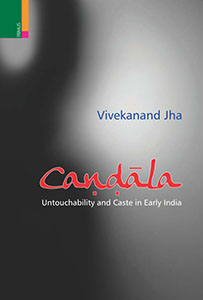
INFORMATION
- AUTHOR : Vivekanand Jha
- HB ISBN : 978-93-86552-55-6
- POD ISBN : 978-93-86552-56-3
- HB Year: 2017, POD Year : 2018
- Extent : 262
- Discount available on checkout
- Usually dispatched within 3 to 5 working days.
Candalas
| HB ₹ 1125 . $ . ₤ |
PB ₹ . $ . ₤ |
|
| POD ₹ . $ . ₤ |
e-Book ₹ . $ . ₤ |
INFORMATION
- AUTHOR – Vivekanand Jha
- ISBN – 978-93-86552-55-6
- Year – 2017
- Extent: 400 + 40 coloured illustrations
- 10% discount + free shipping
- Usually dispatched within 3 to 5 working days.
This volume is a collection of essays on untouchability written by Professor Jha at various points of his long and illustrious career. It dwells on the manner in which social stratification in ancient India developed to exclude castes like Candalas and Nisadas, leading to their exploitation and sub-human treatment. The book begins with tracing the origin and condition of Candalas (1000 BC to AD 600), who were first mentioned in later Vedic literature (1000 to 600 BC) at the Purushamedha (symbolic human sacrifice) dedicated to deity Vayu. Another essay examines the acculturation of the Nisadas-who were mainly fishermen and hunters by profession-which started from the Later Vedic Period. Candalas and Nisadas were both over time assimilated into the Brahmanical caste structure as degraded shudras, and ultimately relegated to being untouchables. The book also examines the Bhagavadgita and Asoka’s Dhamma from the perspective of caste and untouchability. It provides key insights into the origin and growth of the caste system, especially untouchability, extending beyond the brahmanical lens. It is a valuable addition to the study of early Indian social history and social structures.
The Author
Vivekanand Jha was former Director, Indian Council of Historical Research.
This volume is a collection of essays on untouchability written by Professor Jha at various points of his long and illustrious career. It dwells on the manner in which social stratification in ancient India developed to exclude castes like Candalas and Nisadas, leading to their exploitation and sub-human treatment. The book begins with tracing the origin and condition of Candalas (1000 BC to AD 600), who were first mentioned in later Vedic literature (1000 to 600 BC) at the Purushamedha (symbolic human sacrifice) dedicated to deity Vayu. Another essay examines the acculturation of the Nisadas-who were mainly fishermen and hunters by profession-which started from the Later Vedic Period. Candalas and Nisadas were both over time assimilated into the Brahmanical caste structure as degraded shudras, and ultimately relegated to being untouchables. The book also examines the Bhagavadgita and Asoka’s Dhamma from the perspective of caste and untouchability. It provides key insights into the origin and growth of the caste system, especially untouchability, extending beyond the brahmanical lens. It is a valuable addition to the study of early Indian social history and social structures.
The Author
Vivekanand Jha was former Director, Indian Council of Historical Research.
Table of Contents
Table of Contents
| Acknowledgements | Ix-X |
| Introduction – Suvira Jaiswal | Xi-Xiv |
| Candāla And The Origin Of Untouchability | 1-46 |
| From Tribe To Untouchable: The Case Of Nisādas | 47-61 |
| Social Stratification In Ancient India: Some Reflections | 83-104 |
| Stages In The History Of Untouchables | 62-82 |
| Caste, Untouchability And Social Justice: Early North Indian Perspective | 105-120 |
| Social Content Of The Bhagavadgita: Idealized Notion Of Caste Sans Untouchability | 119-170 |
| Aśoka’s Dhamma In Historical Perspective: Vision Bypassing Caste | 171-220 |
| Bibliography | 221-237 |
| Index | 239-242 |




